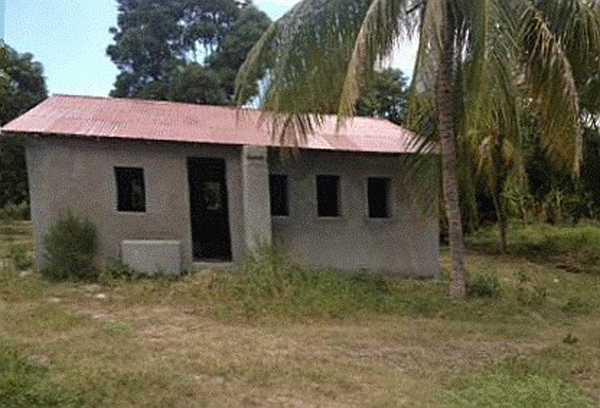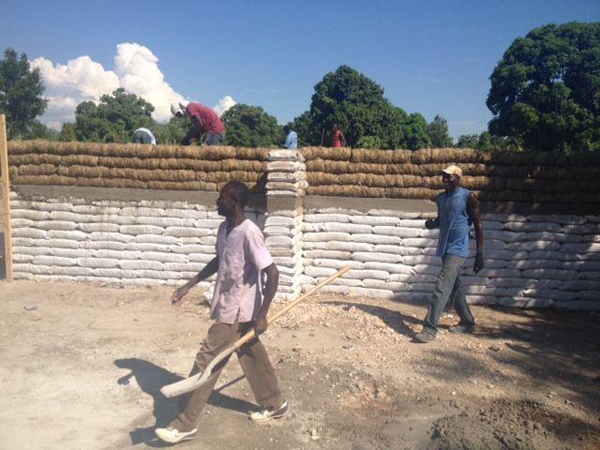
“My Haitian friends with HCDP have built 3 dorms of straw wattle on earthbag base. We sized them to fit the most beds possible, and to add 2 short tents between them so that they could accomodate the most beds possible for occasional classes. Although the reports all say that peasants are very resistant to learning improved agriculture from anyone, Haitian-born HCDP director Gueston Pacius seems to be changing that.

The HCDP builders really like the straw wattle, although in Haiti you have to get straw right at harvest time. They used rice straw from the Artibonite valley available in early summer. This is firmed up with a poured clay slip, and covered with earthen plaster containing a lot of clay. The final weather-resistant surface should be a lime plaster. I’m not sure if HCDP got enough lime, or tried to use some cement stucco. I don’t recommend cement on earth, but they are in a very dry climate and I’ll just have to see what happened, and teach lime plaster next trip.
I recommended small diameter wood poles for reinforcement and for roof trusses. This dorm is just big enough I felt it needed wall reinforcement. A house with rooms only 12′ wide probably wouldn’t in many regions.
The HCDP builders found rebar simpler to reinforce the walls- since it could be inserted into the earthbag walls. I haven’t seen the finished roof yet. I would love to have some engineering help to size some small diameter wood trusses for houses and small dorms/ classrooms.
One thing to make clear is that structural straw wattle is only for tropical and subtropical areas that won’t have heavy snow on the roof.”
Build Simple.org:
“Need help to choose the right inexpensive material for a building? Want to know how to build a sustainable new material? Wondering if you can afford to build something strong enough for your level of quake or flood hazard? Since Patti’s entry was voted number one in the $300 House Contest, she’s focused on exploring new materials to take safe and affordable buildings to new levels.”
Build Simple.org

Owen wants my photo of a recent straw wattle vault compression test. Yes, cheaper materials are needed for roofing. And straw clay is a possibility. But just like earthbag, the waterproofing is critical.
Cement (even half cement half lime) is too liable to crack on earth and earth/straw structures. Any water going into straw wattle would be a mess- mold contaminating the interior air, loss of strength, ultimate collapse.
My best idea for waterproofing a straw wattle vault would be to use Magnesium based cement like Grancrete. But the Grancrete is expensive. I wonder about leaving ties coming through the filling plaster, tying on a thin cotton fabric, and painting that with the Grancrete.
A straw clay vault without wattle might be easier- packed into forms. I’d leave ties through it and snugly tie it to plastic bird netting or heavier mesh inside and out, then plaster. But the waterproofing is critical!
I am testing trash wattle vaults right now, that can be covered with cement. Let us know if anyone is trying any vaults!
Adding a roof over the top is the best.
Roof leaks will dampen walls and attract termites. But if the building owners/ occupants are careful to have a good roof overhang and keep the roof in good repair, then termites are much less likely to invade the wall.
I loved Owen’s test a while back where he took a dried bag of straw clay, covered the top from the rain, and put it on top of a termite mound. Because the termites had other material to eat, they ignored his dry straw and earth block.
Yes, we can’t be sure that termites in the intense damage areas will ignore straw walls. Planting vetiver along the base of the walls will help. Using vetiver grass or vetiver root is even better.
Lime is naturally insect repellant because of it’s high ph. One could also add borax to the clay as an insecticide, but borax is very toxic to any plant life and will not be good composted in future. Perhaps a borax soaked first straw wattle course would be helpful to deter any termites coming through from the earthbag layers.
Ants can also be a problem. Ants are worse than termites in some areas.
This is very inspirational and gives hope to those who really need it. Thank you Patty. People like you and Owen prove there’s still honorable people out there. We need more people of honor today. More than ever.
How about lime . The grasses ? Say buts don’t like. At Auroville in India architect there told me that termites even munch cement. Why not domes, to take care of roofs?
Thank you Patti, thank you Owen. In your wake you leave the world a little better housed. I am inspired by folks who “stand and deliver.”
Thanks Owen.
I guess a lime/clay plaster will keep the termites at bay. Can you confirm that?
Also, Vetiver is in short supply here (I am growing my own for thatch for your roundhouses), is there any other grass which is suitable? I have looked at using/incorporating dried pyrethrum stems but the main grower in Kenya tells me that there is next to no pyrethrin left in the stalks. We could always use pyrethrin insecticide in the clay slip and it is classed as organic but it doesn’t quite sound “natural” to me.
You’ll have to experiment.
Patti Stouter rocks! I can’t wait to try straw wattles. I have vetiver grass in my garden and am interested in using it in wattles/bricks/earthbags. One problem I have is that it has no tensile strength at all. The leaves seem to be fragile. I understood that the straw or rice husks used in earthen building were for tensile strength.
You only need tensile strength when it’s in plaster, and for that you only need a minuscule amount. Vetiver should work fine for everything we’re discussing if used correctly. Just keep in mind these ideas are for emergency shelters in developing countries.
Pagely our web host is dysfunctional at the moment. We’re locked not. Not even sure if this comment will go through.
Hi Patti and Owen
I live in humid tropical Kenya where there are a variety of straws available including Vetiver.
I would like to try a similar building method for certain ancillary buildings such as stores and laundry area etc but am worried about termites in the straw.
Do you have any eco-friendly suggestions?
Our site is suddenly working! Wow. That’s the first time in two days.
Vetiver grass is naturally insect and water resistant. It should work fine, especially if covered with a durable plaster (not earth plaster because the insects might get through and cause problems).